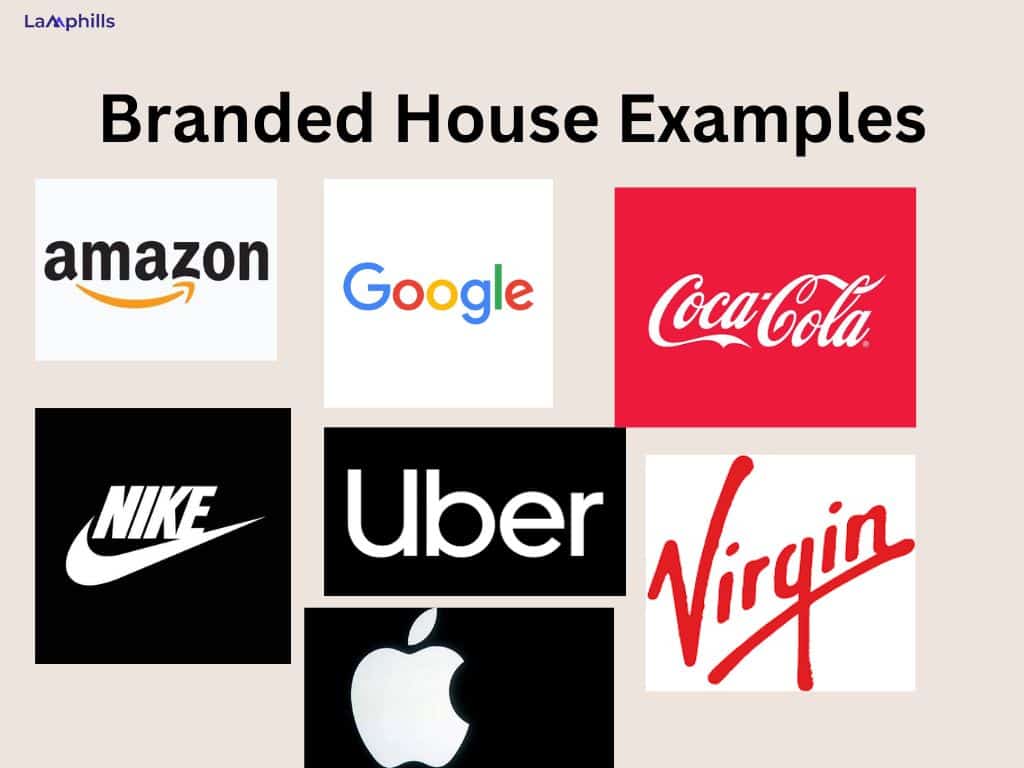Have you ever noticed how some companies have a way of making all their products and services seamlessly blend under one strong brand image? That’s the magic of the Branded House strategy in action.
In this article, I’ll explain the branded house strategy, including what it is, how it works, the key examples, and branded house vs house of brands. So, grab a seat and get ready to explore the power of unified brand identity with some key examples that are sure to inspire!
Key Points
- The branded house strategy uses a single brand name for all products, creating a consistent and recognizable brand image.
- Companies like Apple and Google use this strategy to ensure all their products, from iPhones to Google Search, are trusted and recognizable.
- Virgin Group and Coca-Cola successfully apply the branded house strategy, maintaining a strong, consistent brand identity across various products.
- This strategy differs from a house of brands, where multiple distinct brands operate under one corporate umbrella, like Procter & Gamble.
- A drawback of the branded house strategy is that any issues with the main brand can negatively affect all its products.
Exploring the Branded House Strategy + Key Examples
The branded house strategy, also known as a monolithic brand architecture, is a branding approach where a company uses a single, overarching brand name for all its products and services. This strategy aims to create a strong, consistent brand image across all business offerings. Hence, here are some key examples of companies successfully implementing the branded house strategy:

#1. Apple
Apple is a prime example of a company that effectively employs the branded house strategy. You know when you see that half-eaten apple logo, it’s going to be something unique, innovative, and probably a bit pricey.
They do not, as other corporations do, confuse consumers by using distinct brand names for every product. It’s all just Apple, whether it’s an iPhone, MacBook, or even those fancy Apple Watches. This consistent branding helps us instantly recognize and trust their products because we know what to expect.
For instance, you go to your favorite restaurant. Obviously, you know the quality and experience will be top-notch every time. And that’s why Apple has such a loyal following around the world.
#2. Google
Google, now a subsidiary of Alphabet Inc., is another excellent illustration of the branded house strategy in action. With products ranging from search engines to cloud services to smartphones, Google maintains a cohesive brand image that emphasizes innovation, simplicity, and user-centric design.
This means that whether you’re using Google Search or Google Pixel, you can expect that same familiar Google experience. It’s like they’ve built this strong brand reputation that you can trust, no matter which Google product you’re using.
#3. Virgin Group
Richard Branson’s Virgin Group is a diverse conglomerate encompassing airlines, music, telecommunications, and more. Despite the range of industries Virgin operates in, the company’s brand remains consistent, focusing on customer experience, and innovation.
What’s cool about Virgin Group is how they manage to stay true to their brand across all these different industries. They’re all about the customer experience, always striving to innovate, and embracing that rebellious spirit. It’s like they have this unique identity that ties everything together, no matter what sector they’re operating in.
I think that’s one of the reasons Virgin has been so successful. Indeed, they know what they stand for and they stick to it. It’s all about shaking things up, pushing boundaries, and giving customers something different and exciting. And I must say that it is working pretty well for them.
#4. Coca-Cola
Coca-Cola is a classic example of a company with a strong branded house strategy. I mean, whether you’re drinking a regular Coke, a Diet Coke, or even a Coca-Cola Zero, you still immediately recognize that iconic red and white logo, right? And it’s not just about the logo – it’s about the whole package: the messaging, the visuals, and even the values that Coca-Cola represents.
This consistency is what I call a strong branded house strategy. It’s like Coca-Cola has this unwavering core that runs through all its products, creating this sense of trust and familiarity among consumers. When you see that Coca-Cola label, you know exactly what you’re getting. Indeed, it’s a taste of nostalgia, happiness, and maybe even a bit of refreshment.
And that’s where the magic happens – by sticking to their aims and staying true to who they are, Coca-Cola has managed to build this deep sense of brand loyalty among its customers. People don’t just drink Coke because it tastes good – they drink it because it’s like an old friend, always there to put a smile on your face. And that’s the power of a strong branded house strategy in action. So, you can implement Coca-Cola strategies into your business.
#5. Nike
I love talking about Nike and their iconic slogan “Just Do It!” It’s like their motto that encompasses everything they stand for. When you see that phrase, you immediately think of empowerment, pushing yourself to be your best, and just getting out there and doing it, whatever ‘it’ may be.
Nike knows how to tie everything together with that slogan. Whether you’re looking at their sports apparel or their shoes, that message of performance and athleticism shines through. It’s like they’re saying, “Hey, you’ve got this. Just go for it!”
It’s pretty genius how they’ve managed to convey such a strong and motivating message across all their products. When you wear Nike gear, you feel like you can take on the world, and that’s what makes them unique. I think that’s why so many people are drawn to the brand – because it’s not just about what you wear, it’s about how wearing it makes you feel. And with Nike, you definitely feel like you can conquer anything. Or what do you think about Nike products?
#6. Uber
Here’s another master of the branded house strategy. Personally, Uber has not only nailed the ride-sharing game but has also smoothly integrated other services like Uber Eats and different transportation options under one roof.
What makes Uber stand out is how seamlessly it maintains a consistent user experience and branding across all their services. When you book an Uber ride or order food through Uber Eats, you still get that same familiar and reliable vibe that screams, “This is Uber.”
This approach has played a significant role in Uber’s massive success on a global scale. It’s all about creating that strong and recognizable brand presence that customers trust and rely on, no matter which Uber service they’re using. And that’s the beauty of a branded house strategy – keeping it all under one umbrella while delivering top-notch service across the board.
#7. Amazon
Amazon has truly come a long way from its humble beginnings as an online bookstore. Now, it’s like a virtual shopping mall where you can find almost anything you need. I mean you can buy a new book, order groceries, stream movies, and even host a website on their cloud service, all under the same virtual roof.
What’s cool is how they bring all these services together seamlessly. It’s like they’ve created this ecosystem where you can do anything you want without ever having to leave. Plus, their focus on customer satisfaction is top-notch. I mean, who doesn’t love fast shipping and easy returns?
So, when you think about Amazon, it’s not just a place to shop anymore. It’s a whole experience, a way of life almost. And that’s what makes it stand out as a true powerhouse in e-commerce and technology.
Branded House vs House Of Brands
Branded house vs house of brands is two different branding strategies that companies use to position and promote their products or services in the market.
Imagine a big company like Apple. Everything they make is branded as Apple – from the iPhone to the iPad to the MacBook. The main idea here is that all products and services are tied back to one strong and cohesive brand, creating a sense of unity and trust among consumers. This strategy is all about leveraging the power of one core brand to drive recognition and loyalty across everything the company offers.
On the other hand, a house of brands strategy is more like having a family of brands under one corporate umbrella. Take a company like Procter & Gamble, for example. They own a whole bunch of different brands like Gillette, Pampers, and Tide. Each of these brands operates fairly independently with its own identity and marketing strategies. Therefore, the benefit here is that the company can target different markets and audiences without diluting the strength of each brand.
So, in a nutshell, a branded house is like the all-for-one, one-for-all approach where one strong brand rules them all, while a house of brands is more like a diverse family where each member has their personality and space to shine. It comes down to whether you want to centralize your branding power or diversify it across multiple fronts. Both strategies have their pros and cons, so it’s all about finding what works best for your company and your target audience.
What Is The Difference Between A House Of Brands Strategy And A Branded House?
In a House of brands strategy, a company markets multiple brands that are distinct and separate from each other. Just like Procter & Gamble, they have brands like Tide, Pampers, and Gillette.
On the other hand, a branded house approach relies on one strong, overarching brand with various offerings underneath it. For example, think of how everything under the Google brand umbrella, like Gmail, Maps, and Drive, all connect back to the main Google brand.
In essence, a house of brands is like a family of brands living under one roof, while a branded house is more like different rooms in the same house.
What Are The Disadvantages Of A Branded House?
One of the disadvantages of a branded house strategy is that it can limit the flexibility of the company to diversify its product offerings. This means that if the main brand faces a crisis or loses popularity, all products under that brand could be negatively affected.
Additionally, if the main brand is perceived negatively for any reason, it can tarnish the reputation of all products associated with it. So, while a branded house can create a strong and cohesive brand image, bear in mind that it poses risks in terms of brand reputation and product diversification.
Before you go to the next section, here’s a comprehensive checklist to help you evaluate whether a branded house strategy is the right choice for your business.
Is a Branded House Strategy Right for Your Business?
Is Apple A Branded House?
Yes, Apple is a branded house. This means that all of their products carry the Apple brand and are known for their nice design, user-friendly interface, and premium quality. Whether it’s an iPhone, iPad, Macbook, or any other Apple product, consumers instantly recognize their products. Also, they trust the brand for its innovative technology and seamless integration across devices.
Is Amazon A Branded House Or House Of Brands?
Amazon is more of a branded house than a house of brands. While Amazon offers numerous products and services under its brand name, it also incorporates other brands by allowing them to sell on its platform. This approach helps Amazon to build a strong, recognizable brand while offering customers a variety of choices.
What Is An Example Of A Branded House Hotel?
An example of a branded house hotel is Marriott. Basically, all the hotels under the Marriott brand have a consistent look and feel in terms of branding, amenities, and service.
So, whether you’re staying at a Marriott in New York or Tokyo, you can expect a similar experience in terms of quality and hospitality. It’s like getting the comfort of familiarity wherever you go.
Related Articles
Brand Licensing Done Right: From Concept to Consumer
Brand Guidelines 101: Establishing Your Company’s Voice and Visual Identity
Understanding Brand Dilution: Causes, Consequences, and Prevention
Inspiring Brand Voice Examples: How Top Companies Craft Their Unique Identity






